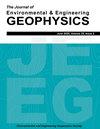Physically Constrained 2D Joint Inversion of Surface and Body Wave Tomography
IF 0.7
4区 工程技术
Q4 ENGINEERING, GEOLOGICAL
引用次数: 0
Abstract
Joint inversion of different geophysical methods is a powerful tool to overcome the limitations of individual inversions. Body wave tomography is used to obtain P-wave velocity models by inversion of P-wave travel times. Surface wave tomography is used to obtain S-wave velocity models through inversion of the dispersion curves data. Both methods have inherent limitations. We focus on the joint body and surface waves tomography inversion to reduce the limitations of each individual inversion. In our joint inversion scheme, the Poisson ratio was used as the link between P-wave and S-wave velocities, and the same geometry was imposed on the final velocity models. The joint inversion algorithm was applied to a 2D synthetic dataset and then to two 2D field datasets. We compare the obtained velocity models from individual inversions and the joint inversion. We show that the proposed joint inversion method not only produces superior velocity models but also generates physically more meaningful and accurate Poisson ratio models.物理约束的二维面波和体波断层成像联合反演
不同地球物理方法的联合反演是克服单个反演局限性的有力工具。体波层析成像是通过对纵波传播时间的反演,得到纵波速度模型。面波层析成像通过对频散曲线数据进行反演,得到横波速度模型。这两种方法都有其固有的局限性。我们将重点放在关节体和面波层析成像反演上,以减少每个单独反演的局限性。在我们的联合反演方案中,泊松比被用作纵波和横波速度之间的联系,并对最终速度模型施加相同的几何形状。联合反演算法首先应用于一个二维合成数据集,然后应用于两个二维野外数据集。我们比较了单独反演和联合反演得到的速度模型。结果表明,联合反演方法不仅能得到更好的速度模型,而且能得到物理上更有意义、更精确的泊松比模型。
本文章由计算机程序翻译,如有差异,请以英文原文为准。
求助全文
约1分钟内获得全文
求助全文
来源期刊

Journal of Environmental and Engineering Geophysics
地学-地球化学与地球物理
CiteScore
2.70
自引率
0.00%
发文量
13
审稿时长
6 months
期刊介绍:
The JEEG (ISSN 1083-1363) is the peer-reviewed journal of the Environmental and Engineering Geophysical Society (EEGS). JEEG welcomes manuscripts on new developments in near-surface geophysics applied to environmental, engineering, and mining issues, as well as novel near-surface geophysics case histories and descriptions of new hardware aimed at the near-surface geophysics community.
 求助内容:
求助内容: 应助结果提醒方式:
应助结果提醒方式:


